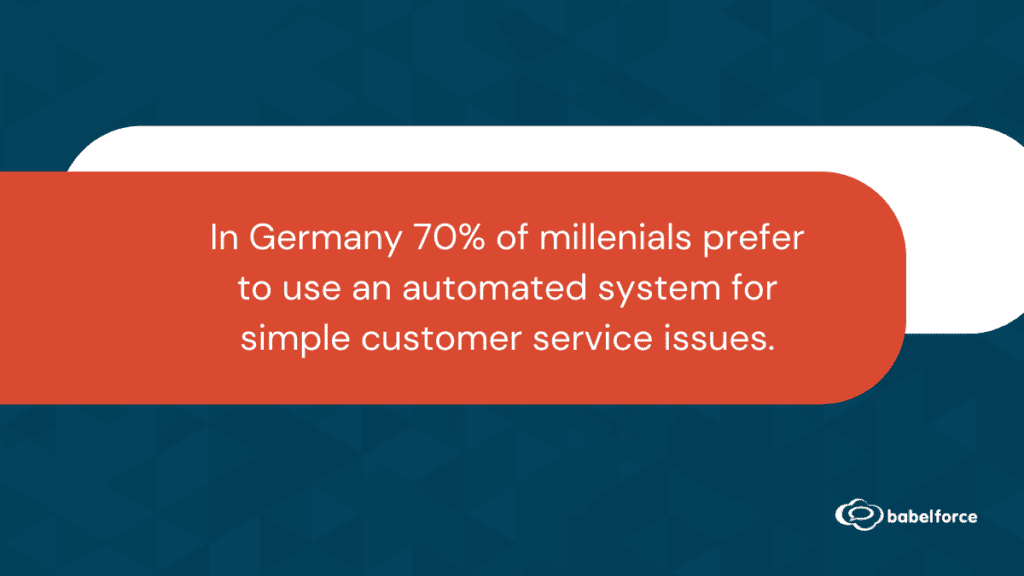No-one is a fan of the traditional “press 2 to talk to support, press 3 to listen to more hold music” call center interaction.
Luckily, customer service VoiceBots are here to give callers a better experience actually listening to them describe what they need. And acting on it.
But they have a mixed reputation because, while the tech has advanced a lot, the earliest VoiceBots in customer service weren’t very good.
You may have had a bad experience like Scottish comedian Kevin Bridges’ battle with an automated cinema booking line back in 2012.
This is an understandable cause for hesitation if you’re thinking of deploying one. Even though the technology has come a long way since then.
So the big question is: have consumers forgotten enough of the bad bots to want to interact with the next generation?
First things first: what is a VoiceBot?
What do we usually associate the word “bot” with? Something rigid and inflexible?
Modern customer service VoiceBots are anything but.
They use natural language processing (NLP) and natural language understanding (NLU) to understand the caller’s speech and the caller’s intent as well.
The intent is the customer’s reason for calling. This might be ‘talk to sales’, or ‘submit a meter reading’ or ‘submit an insurance claim’.
The VoiceBot listens for the intent, and then reacts flexibly to help the caller achieve it. Either by connecting them to the right human agent, or acting independently to update things like meter readings.
This flexible approach to customer service automation has a ton of benefits. It can:
- Help to reduce wait times. VoiceBots can handle simple and common inquiries without the caller needing to wait to speak to an agent. This also means that callers who DO need to speak to an agent don’t have to wait as long.
- Improve call routing. The bot allows callers to travel through the phone system in a ‘straight line’, which is quicker.
- Save costs. Hiring and training agents can be expensive, but VoiceBots are an investment that can unburden human agents by handling repetitive tasks like identity verification.
These benefits all sound pretty good for customers too. But in one 2019 survey, when asked “What comes to mind when you think of AI in relation to customer service?”, the most popular answer from consumers was, “maddening”.
So do consumers like VoiceBots?
Automation is increasingly common in our daily lives. From self-checkouts at the grocery store to online banking, it’s safe to say that most people have encountered it.
Automation that can talk and act independently can be divisive, and there are a few different reactions you can get when you introduce voice automation in customer service.

“I’d rather just talk to a person”
There will always be some people who are resistant to change and prefer traditional methods of customer service. Of course, there’s a simple reason why – people have had bad experiences with earlier automated systems.
“This technology has often been deployed badly and bad bots can be extremely damaging for brands,” says Dr Nicola Millard, Principal Innovation Partner at BT, as part of their Autonomous Customer report of 2023.
And if you’re old enough to have witnessed the advent of automated telephone systems, you’ve probably been subjected to at least one, “I’m sorry, I didn’t understand that” loop.
When surveyed, 50% of Boomers said they prefer human interaction, even as AI continues to improve automated interactions.
One of the main turn-offs for boomers is the perceived impersonal nature of interacting with an automated system – 47% say they find automation impersonal (but only 31% of Gen Z say the same).
“I like Bots if they’re not the only option”
Some consumers will feel a lot better about talking to an AI if they know they can reach a human in situations the AI can’t handle.
For example, the VoiceBot might be set up to process refund requests, but the caller might have a question about the terms and conditions. The bot connects them to an agent who can answer their questions, without making them go to the back of the queue.
This is known as a seamless channel transition, and it’s one of the biggest things that endears automated systems to consumers.
74% of consumers who experienced a seamless transition from self-service to agent say they’ll return to self-service the next time.
You don’t need to give your VoiceBot a novelty voice to make your customers like it.
(Although we’d love to hear from anyone who’s tried this.)
You just need to make sure your VoiceBot can work with the rest of your touchpoints. This way, the automation enhances the experience that’s already there.
This is something we refer to as partial automation, where you don’t just rip out chunks of your service offering and replace them with a robot. Instead you think strategically about how and when to automate.
With a good experience as your end-goal.

“The most convenient option is the best”
We’ve heard so much about how we should be aiming to “delight our customers” and “go above and beyond” to make their experience great.
That’s all well and good, but first you have to complete step one. Make things easy for your customers. According to Gartner, 96% of customers with a high-effort service interaction become more disloyal compared to just 9% who have a low-effort experience. Above all, today’s consumers want convenience.
Thanks to advances in AI, VoiceBots are delivering increasingly low-effort CX. This is filtering down into the consumer consciousness. According to one consumer survey in Germany, 70% of Millennials say they prefer dealing with an automated system for simple customer service issues.
This reflects a broader consumer trend – it’s the younger demographics who are more accepting of automated self-service.
The younger generations (Gen Z and millennials) are more open to using it, if it works correctly, because they’ve grown up using more sophisticated technologies
Giovanna Chethuan Esguerra, a customer success consultant at Zendesk
People forget that conversational AI products such as Siri and Alexa are a widespread and familiar form of technology. For consumers who are used to smart assistants, talking to conversational AI in other settings is a natural evolution.
How do you make everyone happy?
You can’t please everyone all the time, but you can certainly aim to please as many people as possible. In the case of automating customer service, not all VoiceBots are created equal. Bad automation will always be poorly received, but when done well, VoiceBots have the potential to improve CX for both those who like them and those who think they don’t.
For the VoiceBot enthusiasts
BT’s Dr Millard says “The key to effective deployment is a stable and accurate data set.” In other words, a good VoiceBot is only as good as the data it has access to.
This is why many companies are connecting VoiceBots to systems like Zendesk so they can recognize repeat callers and actually help agents to keep tickets up to date.
For the skeptics
For those customers who are not yet convinced by VoiceBots, it might just be a matter of showing rather than telling. Once they experience a well-designed and intelligent VoiceBot, they might be converted.
Provide options
Offering multiple channels for customer service means that everyone can choose the option that suits them best. Some may prefer a call-back option, others might like live chat or email support. Omnichannel support means that each customer can contact you in the way they prefer, seamlessly.
VoiceBots – don’t knock it till you try it
While there will always be skeptics, the potential for VoiceBots to improve customer experience is undeniable. They’re not the rigid and impersonal machines they used to be – they’re smart, easy to use, and efficient. So, it might just be a case of “don’t listen to the haters” and give VoiceBots a chance to show your customers what they can do. And next time you hear someone say, “I don’t like talking to robots”, remind them that these robots have come a long way and might just surprise them.






